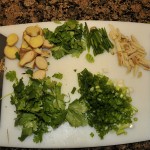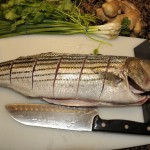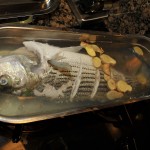I actually enjoy eating stripers! Some interesting trivia about Stripers.
Striped Bass Recipes started with the Pilgrims.
Captain John Smith, wrote in his journal in 1614 “that Striped Bass was a most sweet and wholesome fish as ever I did eat”
And In 1634: William Wood, in his New England’s Prospect, called the Striped Bass “one of the best fishes in the Country . . . a delicate, fine, fat, fish.” Striped Bass were also served at the nations first Thanksgiving.
The Striped Bass, scientifically referred to as Morone saxatilis is endemic to the East Coast. The striped bass has been a prized fish since the Plymouth Colonies in 1670 where they were commercially fished. In 1607, Captain John Smith found the Chesapeake Bay waters clean and clear, free of the phytoplankton clouds that followed in later years. He wrote in 1614 that the fish seemed so plentiful that one might walk “dryshod” across their backs over the river. Striped bass can live up to forty years and reach weights greater than 100 pounds at nearly five feet in length, although individuals larger than 50 pounds are considered an absolute trophy fish and a possibly once-in-a-lifetime. According to Dan Blanton, A striper weighing 108 lbs was verified by the DFG in San Luis Resevoir. The all-tackle angling record fish, taken in New Jersey, in the salf, in 1982, weighed 78 ½ pounds. All striper records out of San Luis are classified as Landlock Stripers and I have never seen signs of the ocean in any striper I have caught in San Luis over the last 30+ years. The migratory behaviors of coastal striped bass are more complex than those of most other anadromous fish, which spend most of their adult lives in the ocean but migrate up rivers and streams to spawn. Striped Bass seasonal movements depend upon the age, sex, degree of maturity and the river in which they were born. Even though Strippers are anadromous, scientist believe that the damming of rivers led to some species becoming landlocked . There are very few successful spawning populations of freshwater striped bass that retained a landlocked breeding population . I have talked to some biologist who believe that the San Luis Stripper polulation is one of those freshwater sustained systems with the fish moving to and from the San Joquine river watershed and in and out of the lakes. San Luis Resevoir has never had a formal stocking program in its history.
Here is my favorite recepie for a fresh 20 inch Striper.
Steamed Striper
Ingredients
18 – 24 inch Striper (freshly caught) Big enough to fit into the poaching pot
1 teaspoon coarse sea salt or kosher salt
A Handfull of fresh sliced ginger
1/2 cup of Green Scallions chopped (save a little sliced for garnish)
1/2 cup dark soy sauce
1/2 cup of peanut or cooking oil
1/4 cup sesame oil
1/2 cup lightly packed fresh cilantro sprigs
Directions
- Pat cleaned whole Striper with paper towels. Rub both sides of fillet with salt. Cut slashes into sides of striper so it poaches evenly. Place sliced ginger and a little sea salt into poacher filled with water (enough to cover the fish) and bring to a rolling boil.
- Place the striper into the boiling water and cover. Poach for 7 minutes (exactly) and transfer to serving dish.
- While fish is boiling, heat seasame and peanut oil in frying pan with chopped garlic.
- Brown cilantro and scallions in oil till slightly brown
- Pour accumulated water out of the dish with fish and sprinkle the fillet with green onion.
- While the browned cilantro, scallions and oils are hot, pour the entire frying pan over the striper. It should splatter and sizzle when it hits the wet fish.
- Immediately pour the soy sauce over the fish
- Garnish with cilantro sprigs and serve immediately. Best served with rice.
The Circle of life
Man ties fly.
Fish eats fly,
Man eats fish.
Fish helps man live longer.
Repeat.


















